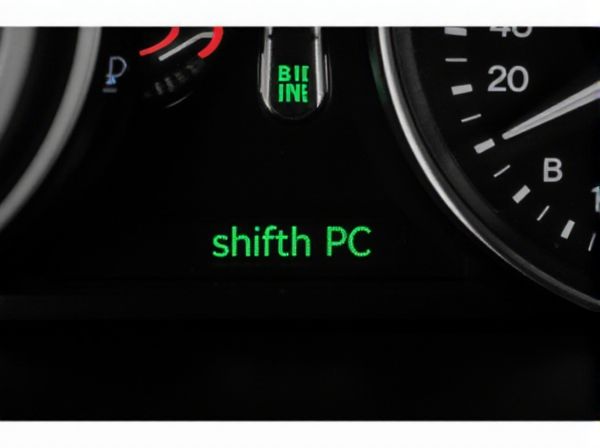
Photo illustration: Gear Position Indicator vs Shift Light
A Gear Position Indicator displays your current gear on the dashboard, helping you monitor and optimize performance while driving. A Shift Light, on the other hand, signals the ideal moment to change gears, maximizing engine efficiency and preventing over-revving. Choosing between these depends on whether you prioritize real-time gear awareness or precise shift timing during your driving experience.
Table of Comparison
| Feature | Gear Position Indicator | Shift Light |
|---|---|---|
| Purpose | Displays current gear on dashboard | Signals optimal shift timing with light |
| Display Type | Digital or analog gear readout | LED or indicator light |
| Driver Benefit | Clear gear awareness for better control | Promotes fuel efficiency and performance |
| Typical Use | Standard in manual and some automatic cars | Common in performance and racing vehicles |
| Installation | Integrated in dashboard cluster | Mounted near tachometer or dashboard |
| Cost | Usually standard, no additional cost | May be aftermarket or premium feature |
Introduction to Gear Position Indicators and Shift Lights
Gear Position Indicators display the current gear in use, providing real-time data that enhances driver awareness and helps maintain optimal engine performance. Shift Lights serve as visual cues signaling the best moment to change gears, improving acceleration efficiency and preventing engine over-revving. Both devices contribute to improved driving precision and vehicle performance by offering critical gear-related feedback.
Functionality: Gear Position Indicators Explained
Gear position indicators display the exact gear a vehicle is currently in, providing real-time data to enhance driver awareness and optimize performance. These systems use sensors connected to the transmission to relay accurate gear information on the dashboard, improving safety and efficiency during shifts. Unlike shift lights that only signal optimal shift points, gear position indicators offer comprehensive feedback for precise manual and automatic gear control.
Functionality: Shift Lights Explained
Shift lights serve as visual indicators that alert drivers when to change gears to optimize engine performance and fuel efficiency. Unlike gear position indicators that display the current gear, shift lights use LED signals or illuminated bars to prompt timely gear shifts, preventing engine strain and improving acceleration. This functionality enhances driving precision by providing immediate feedback on optimal shift points, especially in high-performance or racing scenarios.
Key Differences Between Gear Position Indicators and Shift Lights
Gear position indicators display the current gear selected, providing real-time information to the driver for better control and efficiency, while shift lights signal the optimal time to change gears based on engine RPM, enhancing performance and preventing engine strain. Gear position indicators rely on sensor data from the transmission, whereas shift lights are typically programmable alerts triggered by engine speed thresholds. The key difference lies in their function: gear position indicators inform about gear status, and shift lights guide shifting timing for optimal performance.
Accuracy and Responsiveness Comparison
Gear Position Indicators provide precise digital readouts of the current gear by directly interfacing with the transmission sensor, ensuring high accuracy without delay. Shift Lights rely on preset RPM or speed thresholds to signal optimal gear changes, which can lag due to calibration and engine performance variability. The direct feedback from Gear Position Indicators offers superior responsiveness and accuracy compared to the predictive nature of Shift Lights, making them more reliable for performance driving.
Installation and Compatibility Considerations
Installing a gear position indicator requires direct wiring to the transmission sensor or the ECU, demanding compatibility with the vehicle's specific make and model for accurate data transmission. Shift lights typically connect to the RPM sensor or ECU as well, but their installation often involves mounting the light within the driver's line of sight, emphasizing ergonomic placement over complex wiring. Ensuring compatibility with the vehicle's electronic systems and dashboard layout is crucial for both devices to function correctly and provide reliable real-time feedback during driving.
Benefits of Gear Position Indicators
Gear Position Indicators provide real-time, precise gear information that enhances driving accuracy and reduces mis-shifting, improving overall vehicle performance. Unlike shift lights that simply signal the optimal shift point, gear position indicators allow drivers to maintain better control during complex driving scenarios, such as racing or off-road conditions. This direct feedback helps protect the transmission, extend its lifespan, and optimize fuel efficiency by enabling more informed gear selection.
Benefits of Shift Lights
Shift lights provide immediate and clear visual cues for optimal gear changes, enhancing driving performance and fuel efficiency by preventing engine over-revving. Unlike gear position indicators that display current gear information, shift lights proactively alert the driver to shift at the precise RPM, improving reaction time and reducing engine wear. These benefits make shift lights particularly valuable for racing and performance driving conditions.
Which is Better for Performance Riding?
Gear Position Indicators provide precise real-time information about the current gear, allowing riders to optimize shifting for smoother acceleration and better control during performance riding. Shift Lights signal the optimal shift point based on engine RPM, helping riders maximize power output and prevent over-revving, which is crucial for competitive racing environments. For performance riding, Shift Lights often offer a more intuitive and immediate cue for shifting, while Gear Position Indicators enhance overall situational awareness, making the choice dependent on riding style and preference.
Choosing the Right Solution for Your Needs
Choosing between a Gear Position Indicator and a Shift Light depends on your driving style and preferences; Gear Position Indicators provide real-time visualization of the current gear, enhancing clarity for both manual and automatic transmissions. Shift Lights offer timely visual alerts for optimal shifting points, ideal for performance driving where maximizing engine efficiency matters. Evaluate your vehicle's setup and your focus--whether precise gear awareness or shift timing--to select the solution that best supports your driving goals.
 caratoz.com
caratoz.com